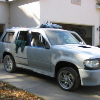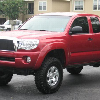OK, so after dropping my '13 off today for this issue, I've spent the day thinking about it. I've read a lot of this thread, but Ford will have a fix before I can wade through 93 pages, so...
I saw it asked, but never saw it answered; is it only the 3.5L engines that have this issue? Not the 4 cylinders?
I was talking to a friend about the issue. Neither of us are engineers, nor are we ASE certified mechanics, nor Ford experts. That said, we independently came to the same point, which is that there's no way that this is coming from the rear of the vehicle. I won't say it's impossible, but certainly highly improbable. I would hope that people at Ford have considered these things, but since this is the direction they're moving, I have my doubts.
Consider that the majority report only noticing the smell at WOT. That means the vehicle is moving, and accelerating, so there is wind blowing front to back. That being the case, how, short of magically overcoming the laws of physics, is the Explorer sucking exhaust fumes in from the back?!? Somehow, the exhaust is exiting the tail pipe, and despite all of the wind blowing in the opposite direction, that exhaust is being pulled forward into the cabin? At 60+ mph, in my case? I just don't buy it. Ever blown cigarette smoke out the window of a moving car? How is it being pulled forward? It's not.
My friend and I both said 'it has to be coming from forward of the firewall'. That's the only way we could be smelling it in the front seat, while running WOT. So, looking at it from that perspective, where is it really coming from?
I have three ideas, and it could be any one, or a combination, and these would explain why it happens to some, but not others.
First, is a leaking exhaust gasket. If, like many, Ford uses multiple suppliers for gaskets, and one of those suppliers is using an "acceptable", but slightly different material for the gasket, that gasket might not be holding up under higher temperature and/or pressure.
Second, and potentially related, is inadequate torque on the bolts in the exhaust, from the manifolds back. Torque is generally spec'd in a range. If the lower end of that range is actually not sufficient to maintain the seal, or in combination with an inadequate gasket, the lower end of the spec doesn't completely seal it, that could allow exhaust to leak under limited circumstances, again of higher temp/pressure.
Last, is faulty welds in the exhaust. It would only need to be a small one, in a hard to find spot, or worse, in any of several hard to find spots, to allow this to happen.
If this is only happening on the V-6s, that would add a little weight to these ideas, as the 4 cylinders would have different manifolds, gaskets, etc.
With the current "fix", they're sealing the body seams. Maybe that needs to be done up front to, or instead. Or it's coming in somewhere else up front, and the recirculate thing is just pushing it further into the cabin, faster, because it's leaking in somewhere on the front floor, where that recirc air is being picked up.
My personal experience has been that the hotter it is outside, and therefore the hotter the vehicle, the worse the odor. When it's over 90, it comes in heavy, recirc or not.
It seems like there has to be some sort of sniffer that could figure out if there is a small leak up front. I know someone mentioned contacting a lab, back in the first 15(?) pages, but I didn't see what came of it, if anything.
Thoughts?











